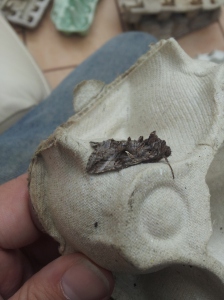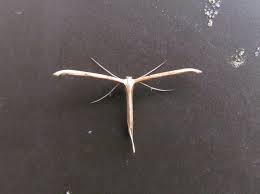As stated on the new moth page (no idea as yet how to specifically separate these posts from the conservation stuff and add them on to the moth page, any answers?) I’ve been trying to get to grips with moths.
This year I’ve decided to try and do it properly, namely by getting a newer bigger and allegedly better moth trap, expanding my moth reference material, and trapping on more regualar basis, rather than the ‘ad-hoc when I could be bothered’ basis of the past.
What’s my equipment then? Glad you asked.. I’ve got two moth traps, my older Skinner Trap with a 15 watt actinic tube light, and my brand new Robinson Light with an ‘eco’ 20 watt black-light bulb (essentially the same as the 15w tube but just folded up like an energy saving light-bulb and slightly more powerful). To translate this into English I’ll explain the two.
The Skinner Trap is a wooden box with two perspex sheets angled down from the sides towards the middle of the box (like this |\/|) with a bulb in between the two perspex sheets. The idea is the moths are attracted to the light, fly around the bulb for a bit before getting trapped beneath the funnel-like perspex in the box. The box is filled with egg-carton to provide the moths with a place to hide. My Skinner trap has an actinic tube light, which means it runs on hardly any power and omits an ultra-violet light.
A Robinson Trap works on a similar principle to the Skinner, only it is rounded, larger, and has the bulb is positioned slightly differently . The moths this time fall through a much smaller opening in the trap so are much less likely to escape than in the Skinner trap. My Robinson trap has a black-light actinic light but most are operated with an ultra-bright 125 watt Mercury Vapour light, similar in light intensity to a collapsed sun but capable of attracting literally hundreds of moths. My bulb attracts significantly less but is kinder to the environment and to the neighbours!
So in theory my new Robinson Trap should contain more moths in the morning than my old Skinner. Well up to this morning there was no difference! On average the Robinson was attracting maybe 2 moths per trapping session (limited to weekends at the moment due to work), my old Skinner has a similar if not slightly better hit rate.
However, the summer of 2015 in North-west England occurred in April and has been postponed until further notice, hardly ideal moth trapping conditions so it may not be the trap’s fault.
This morning’s count was really good however, 22 individual moths from 12 different species. Comfortably the best trap ever in the garden. The run down as follows (in the order I ID-ed them!:
1 Poplar Hawk-moth, 9 Heart and Darts, 1 Light Brown Apple Moth, 1 May Highflyer, 1 Silver Y, 1 Green Pug, 1 Bee Moth, 2 Flame Moths, 2 Tachystola acroxantha, 1 Blastobasis adustella, 1 Willow Beauty, and one unidentifiable well-worn Pug moth.



